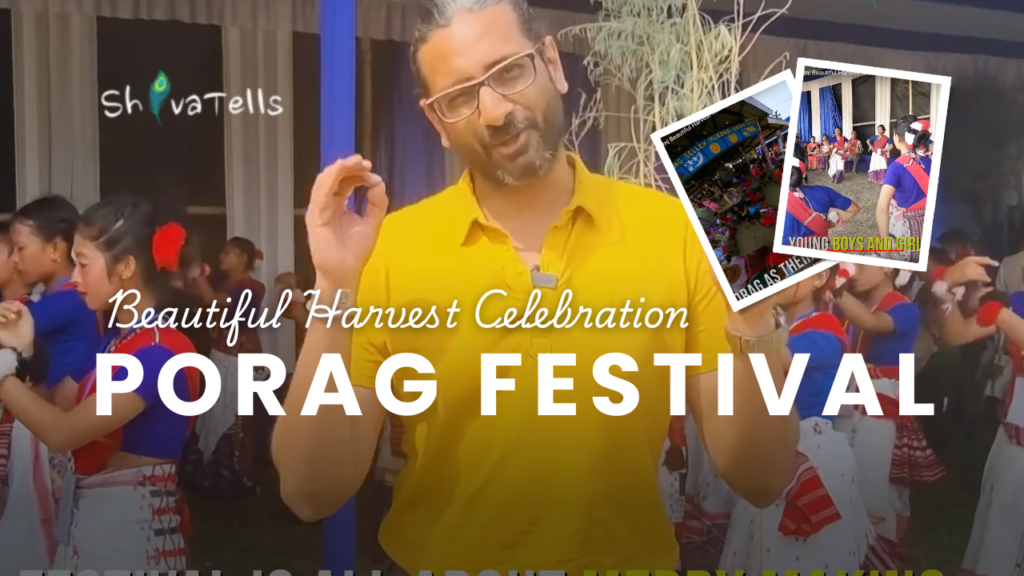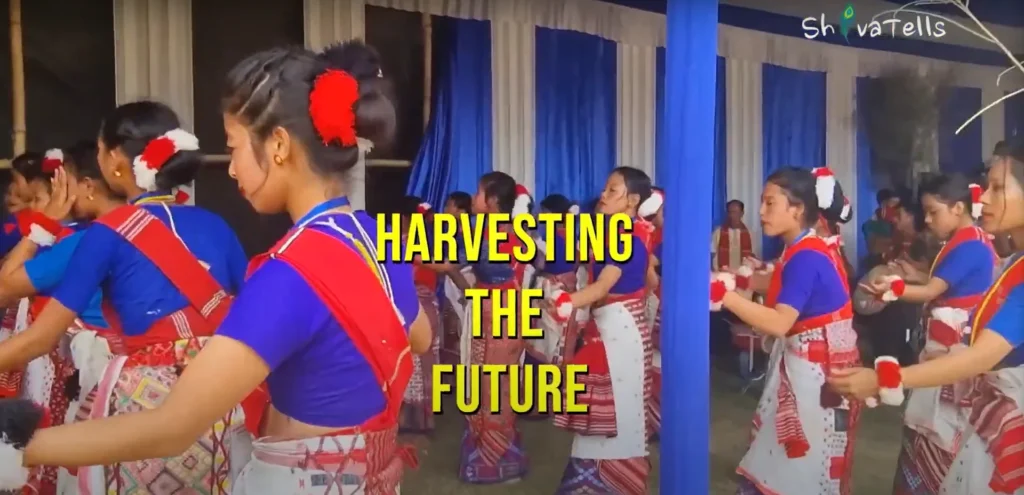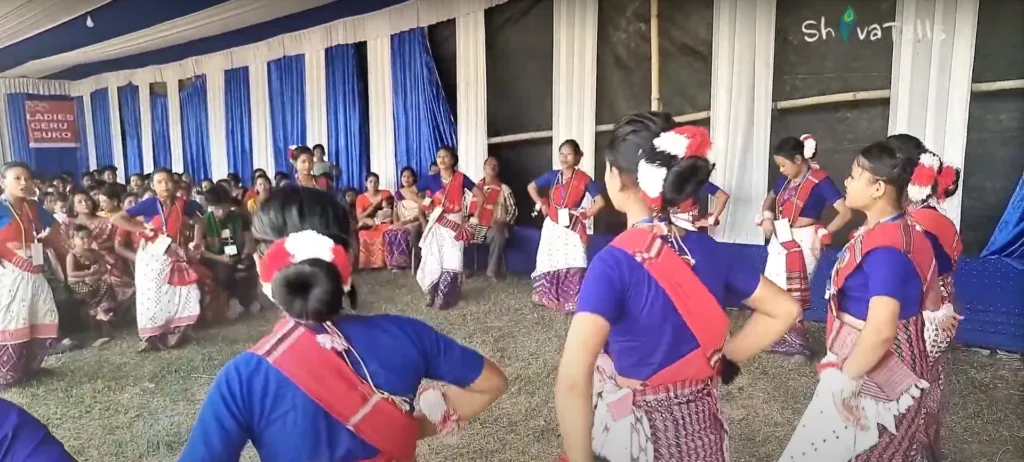When I first heard about the Porag Festival of Assam’s Mising Tribe, I knew it was special. But nothing could have prepared me for the deep, spiritual experience I was about to witness. This is not just a festival; it’s a harmonious blend of tradition, culture, and a profound love for nature. It’s the Mising people’s way of giving thanks to the earth, celebrating their harvest, and connecting with their ancestors. The air was filled with a feeling of gratitude and togetherness as I stepped into this sacred celebration.

Table of Contents
The Mising Tribe: Keepers of Tradition and Culture

The Mising Tribe is one of Assam’s Indigenous groups, believed to be descendants of the Tani tribes of Arunachal Pradesh. The tribe has maintained its unique cultural identity, despite the rapid changes in the modern world. For the Mising, life is simple and deeply intertwined with nature. Their festivals, especially Porag, reflect this connection and keep their age-old traditions alive.
The Mising people live along the banks of the Brahmaputra River. The rivers, mountains, and forests are their lifeblood, and their respect for the natural world is evident in every aspect of their daily life. Their connection to nature is not just about survival—it’s about harmony and reverence for the earth that sustains them.
The Origin and Significance of the Porag Festival
The Porag Festival is a post-harvest celebration that takes place every three to five years. It’s a time when the Mising Tribe gathers to celebrate the fruits of their labor, give thanks to the earth, and seek blessings from their gods for the coming year. The festival is deeply spiritual and involves various rituals and ceremonies designed to ensure the well-being of the community and their crops.
What struck me most about Porag is its connection to the past. It is said that the festival dates back centuries and was originally celebrated to honor the deities who protect the land. Today, Porag still serves this purpose, but it has also become a symbol of unity for the Mising people. It’s a way for the tribe to come together, reaffirm their identity, and strengthen their bond with the natural world.
When and Where: The Heart of the Festival
The Porag Festival is not held every year; its timing is determined by the harvest and the needs of the community. It usually takes place after the harvest season, between November and January, when the crops are safely stored, and the hard work is done. The festival is celebrated in Mising villages across Assam, and each village takes turns hosting the event.
I was fortunate enough to visit one such village during Porag, and the experience was unlike anything I’ve ever encountered. The entire village was decorated with vibrant colors, and there was an air of excitement as people from neighboring villages arrived to join in the festivities. The community spirit was palpable, and I could see how much this festival meant to the Mising people.
Rituals and Offerings: A Sacred Connection to the Earth
At the heart of the Porag Festival are the rituals and offerings made to the deities. The Mising people follow the Dhoni Polo faith, which worships the sun and moon as powerful deities. As part of the festival, three pigs are sacrificed: one for Dhoni (the sun), one for Polo (the moon), and one for their ancestor Abu Tani. These sacrifices are made to appease the gods and ensure the health and prosperity of the tribe.
The Mibu, or priest, plays a crucial role in the festival. He is believed to be in direct communication with the gods and ancestors, and he must conduct the rituals and offer prayers for the well-being of the community. I watched in awe as the Mibu performed his sacred duties, his chants rising into the night sky, carrying the hopes and prayers of the Mising people.
The rituals are not just for show; they are deeply spiritual, and photography is not allowed during these ceremonies. The Mising people believe that capturing these moments would interfere with the spiritual process, and I respected their wishes, choosing instead to immerse myself fully in the experience.
Music and Dance: The Heartbeat of the Porag Festival

No celebration is complete without music and dance, and Porag is no exception. Traditional Mising music is played on instruments made from bamboo and other natural materials, and the songs tell stories of the land, the people, and their gods. The music is rhythmic and soulful, and it’s impossible not to be swept up in its energy.
Dance is an essential part of Porag. The young boys and girls of the tribe take part in vibrant folk dances that express joy, gratitude, and hope for a bountiful future. As I joined in, I felt the energy of the group and the connection between the dancers and the land they celebrated. It wasn’t just entertainment—it was a way for the Mising people to express their deep bond with nature and each other.
Agriculture and the Role of the Harvest
The Porag Festival is, at its core, a harvest festival. The Mising Tribe relies heavily on agriculture, and the festival serves as a way to give thanks for the year’s bounty. The land is their greatest resource, and Porag is a time for them to express their gratitude and hope for a prosperous future.
The crops they grow—rice, vegetables, and other staples—are more than just food; they are a source of life. During the festival, the tribe shares their harvest, symbolizing the importance of community and collective well-being. It was inspiring to see how much pride they took in their work and how grateful they were for the gifts of the earth.
Feasting and Togetherness: A Celebration of Community
The communal feasts during Porag are a highlight of the festival. The food, prepared with love and care, reflects the bounty of the harvest. Traditional Mising dishes made from locally sourced ingredients are shared among the villagers and guests, and the feast is a time for everyone to come together and celebrate the bonds of family and friendship.
I was invited to join the feast, and it was an unforgettable experience. The warmth and hospitality of the Mising people made me feel like I was part of their community, even though I was just a visitor. As we sat around the fire, sharing stories and laughter, I realized that this is what Porag is truly about—coming together as one to celebrate the blessings of life.
Porag Festival Attire: A Reflection of Tradition
The colorful traditional attire worn during the Porag Festival is a sight. The women wear intricately woven mekhela chadors, while the men don traditional dhotis and games. These garments are not just clothing; they reflect the Mising Tribe’s rich cultural heritage.
The tribe takes great pride in their traditional attire, and it’s clear that these garments hold deep meaning. The colors, patterns, and designs all have symbolic significance, representing different aspects of nature and the tribe’s connection to the land.
Preserving the Culture: The Future of Porag Festival
As I watched the young boys and girls dance, I couldn’t help but think about the future of this beautiful tradition. The Mising Tribe is deeply committed to preserving its cultural heritage, but like many Indigenous communities, they face challenges. The younger generation is becoming more influenced by the modern world, and there is concern that the traditional ways may fade with time.
However, the elders of the tribe are determined to pass on their knowledge and traditions to the next generation. They believe that festivals like Porag are essential for keeping their culture alive and maintaining their connection to the land.
Experiencing Porag as a Visitor: A Journey of Gratitude
For anyone who wants to experience the Porag Festival firsthand, I can’t recommend it enough. It’s not just a festival—it’s a journey into the heart of a culture that is deeply connected to the earth and to each other. As a visitor, I felt privileged to be part of something so special, and I left with a renewed appreciation for the importance of tradition, community, and the natural world.
The Porag Festival is more than just a celebration of the harvest. It’s a reminder that we are all part of something bigger—that our connection to the earth and to each other is what sustains us.
Explore the Enchanting Banks of the Brahmaputra River
Assam, with its majestic Brahmaputra River, is a treasure trove of culture and natural beauty. Here are some must-visit destinations that showcase the essence of this vibrant region:
- Guwahati: As the largest city in Assam, Guwahati is a bustling hub filled with spiritual sites like the revered Kamakhya Temple and the serene Umananda Island. Don’t miss the lively local markets that offer a taste of Assamese culture.
- Majuli: Step into the world’s largest river island, Majuli, where traditional Satras (monasteries) and vibrant festivals create a unique cultural tapestry. The lush landscapes and tranquil ambiance are perfect for those seeking a serene retreat.
- Tezpur: Known for its rich history, Tezpur boasts beautiful sites like the Agnigarh hill and the picturesque banks of the Brahmaputra. It’s an ideal spot for nature lovers and history enthusiasts alike.
- Jorhat: This charming town is the gateway to Assam’s famous tea gardens. Explore the Jorhat Gymkhana Club and take a short trip to Majuli for an unforgettable cultural experience.
- Kaziranga National Park: Just a short drive from the river, this UNESCO World Heritage Site is famed for its population of one-horned rhinoceroses. Embark on a thrilling safari to witness the diverse wildlife in their natural habitat.
- Sibsagar: Dive into the history of the Ahom dynasty in Sibsagar, where you can visit ancient temples and the iconic Sibsagar tank, reflecting the architectural brilliance of the past.
- Hajo: A melting pot of religions, Hajo is a sacred site for Hindus, Buddhists, and Muslims. Visit the Hayagriva Madhava Temple and the Powa Mecca, and soak in the harmonious atmosphere.
- Nameri National Park: Perfect for adventure seekers, Nameri offers opportunities for trekking, birdwatching, and even river rafting along the scenic banks of the Brahmaputra.
Other stories from Assam
- King Sukapha’s Ahom Kingdom: Exploring the Cultural and Historical Gems of Assam
- This Man from Assam lives and loves ORCHIDS!
- The Judima Festival – Dima Hasao’s Hidden Rice Beer Festival!
